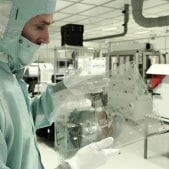We offer prepackaged precursors in ALD Cylinders!
Atomic layer deposition (ALD) using Tin (Sn) based compounds have been widespread in applications, such as sensors, Li-ion batteries, catalysts, photovoltaics. Recently, researchers have reported state-of-the-art applications like 3D thin-film solid-state batteries (by Pearse et. al.) and efficient perovskite solar cells (by Guan et. al. and Sun et. al.). Many of these applications feature layers that are susceptible to degradation at elevated temperatures. It’s mandatory to deposit SnO2 below 200°C for applications such as perovskite and silicon heterojunction solar cells. Alternatively, plasma-enhanced atomic layer deposition (PEALD) with Strem Chemicals’ highly reactive metalorganic precursor, tetrakis(dimethylamino)tin (TDMASn), with a decomposition temperature range of 250–300°C, also enables low deposition temperatures.
Figure 1. 50-1815 Structure
Strem Chemicals offers TDMASn [Sn[N(CH3)2]4] (catalog number 50-1815) precursor, which has been widely accepted in the PEALD community worldwide for the deposition of tin-based compounds. The colorless to pale yellow liquid phase precursor with a density of 1.169 at 20°C and vapor pressure of 15 Torr is sold pre-packed, in an ALD cylinder by Strem Chemicals (98-4050).
Figure 2: Strem Chemicals pre-packed ALD cylinders
The following are some of the examples of PEALD processes employing Strem supplied TDMASn precursor presented by diverse groups of researchers.
Hoffmann et. al. report the preparation of transparent conductive gas permeation barriers based on thin films of tin oxide (SnOx) grown by spatial atomic layer deposition (ALD) at atmospheric pressure. They present a comparative study using tetrakis(dimethylamino)tin(IV) and various oxidants (atmospheric pressure oxygen plasma, ozone, and water) at process temperatures in the range of 80–165°C. (Link)
Recent reports by researchers from the Eindhoven University of Technology in collaboration with the Netherlands Organisation for Applied Scientific Research (TNO), present an extensive characterization of plasma-assisted atomic-layer-deposited SnO2 layers. They aim at identifying key material properties of SnO2 to serve as an efficient electron transport layer in perovskite solar cells. The SnO2 thin films were deposited at substrate temperatures of 50, 100, 150, and 200°C on Czochralski polished c-Si (100) wafers and indium tin oxide (ITO) glass substrates in an Oxford Instruments OpAL ALD reactor using tetrakis(dimethylamino)tin (TDMASn) (99% purity, Strem Inc.) as the tin precursor and radio-frequency (RF) inductively coupled oxygen plasma as the co-reactant. (Link)
Figure 3: Perovskite solar cells are one of the most promising emerging cell technologies with fast recent improvement in cell efficiency shown above red/yellow circles reaching >22% cell efficiency (From Wikimedia Commons, the free media repository).
An American researcher from University of Maryland, U.S. Naval Research Laboratory and Sandia National Lab, has reported the experimental realization of fully conformal 3D thin-film solid-state batteries (3D TSSBs) incorporating a SnNx anode (deposited at 200°C using TDMASn and an N2 plasma), demonstrating the simultaneous power-and-energy benefits of 3D structuring. All active battery components—electrodes, solid electrolyte, and current collectors—were deposited by atomic layer deposition (ALD) onto standard CMOS processable silicon wafers. The wafers were microfabricated to form arrays of deep pores with aspect ratios up to approximately 10. Their work shows that the exceptional conformality of ALD, combined with conventional semiconductor fabrication methods, provides an avenue for the successful realization of long-sought 3D TSSBs which provide power performance scaling in regimes inaccessible to planar form factor cells. (Link)
Since 1964, Strem Chemicals, Inc. has been serving its clients from academic, industrial and government research and development laboratories as well as commercial scale businesses in the pharmaceutical, microelectronic and chemical/petrochemical industries. Strem (Headquarters: Newburyport, Massachusetts, USA) is a high purity specialty chemicals manufacturer and supplier. Strem also provides custom synthesis (including high-pressure synthesis) and current good manufacturing practice (cGMP) services. Strem’s products are of high purity, typically 99%, with some at 99.9999% metals purity.
More than fifty years of experience in manufacturing inorganic and organometallic chemicals has enabled Strem to expand its product offering of MOCVD, CVD, and ALD precursors. They’re continually adding new products for this dynamic and exciting field. Strem’s product range includes:
Additional Resources:
Full Line of High Purity CVD/ALD Precursors
CVD/ALD Precursors contained in Swagelok® Cylinders
Cylinder and Adaptors
Metal Amidinates for CVD/ALD Applications
MOCVD, CVD & ALD Precursors Booklet
Stainless Steel Bubblers: Vertical Electropolished
----------
Promotional blog written and researched by Abhishekkumar Thakur and Jonas Sundqvist, BALD Engineering AB



%20(1).png)











